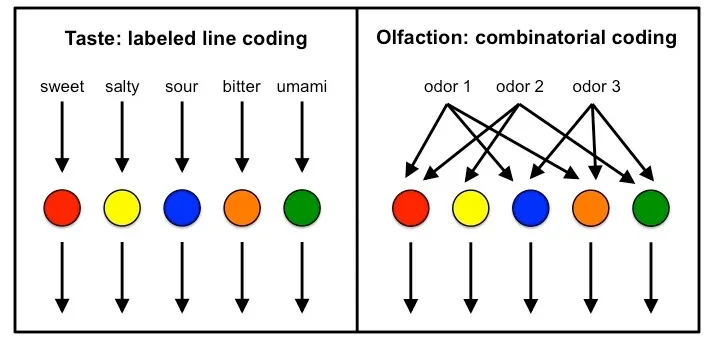Biology of sensory perception
5 Differences Between Taste and Smell
Chemosensory perception of food occurs in the mouth and nose. The integration of taste and smell perceived enables us to perceive the flavour of a food.
Think about strawberry candy. It usually is red which acts as a visual cue and creates the expectation that it will taste like a red fruit. When eating, sweet and sour tastes are combined with a strawberry aroma, giving a strawberry flavour. Without being able to smell the strawberry aroma, the candy would only give a sweet and sour taste.
The same goes for lemon candy, without being able to smell the lemon aroma, the candy would only give a sweet and sour taste.
As you may have read in the earlier chapters, the sense of taste and smell has different biological pathways. Taste signals first go to the brainstem and are then further transported, while smell signals go directly to the olfactory bulb, which is connected to areas of the brain involved in memory and emotion, such as the limbic system.
In contrast to taste, which has only five basic types, an endless number of smells exists. This difference is due to combinatorial coding of olfaction versus labelled line coding in taste, as is further explained in Figure 4. Labelled line coding in taste perception refers to the idea that each taste quality is transmitted by specific, dedicated pathways to the brain.
Each taste quality has multiple stimuli. For example, sweet taste can be signalled by different sugars and artificial sweeteners, and bitter taste can be signalled by a variety of bitter compounds.
Tastes are also signalled through multiple types of receptors. For instance, bitter tastes can be sensed by various receptors from the TAS2R family, umami by TAS1R1 and TAS1R3 receptors, and sweet by TAS1R2 and TAS1R3 receptors.

Figure 4. Illustration of labelled line coding (taste) and combinatorial coding (olfaction).
The taste system is simple; one taste compound only activates one type of taste neuron, meaning that with five types of cells, five types of tastes can be found. In olfaction, each odour can activate multiple types of olfactory neurons, and each neuron can be activated by multiple odours. The brain will read out what combination of neurons has been activated, and what that means.
From: Taste and Smell: Sensing the Chemical World by Anita Devineni [1]. License: CC BY
The differences and interactions between flavour, taste and aroma are further explained in Video 2. In Table 4, the differences between taste and smell are summarised.
Table 4. Summary of the differences between taste and smell
Taste:
- Five (or six) basic tastes
- Easy to name
- Indirect information signalling to the brain via brainstem
Smell:
- Infinite number of aromas
- Difficult to name and describe
- Direct link to brain
- Direct anatomical link to memory and emotions in the brain
- https://www.brains-explained.com/taste-and-smell/ ↵
the sensation of flavor perceived in the mouth and throat on contact with a chemical substance.
Smell. When a compound is aromatic, it gives a smell.
Taste plus aroma.
The brainstem is the lower, stalklike part of the brain. It connects the brain and spinal cord and carries signals that control body functions.
The olfactory system uses combinations of receptors to detect a wide range of odors, reducing the need for a specific receptor for each odor.
This is one of my anki cards I made.
The labelled lines model in (terms of taste) explains that each taste bud receptor has 5 axons, all which send separate taste information to different parts of the gustatory (taste) cortex in the brain.